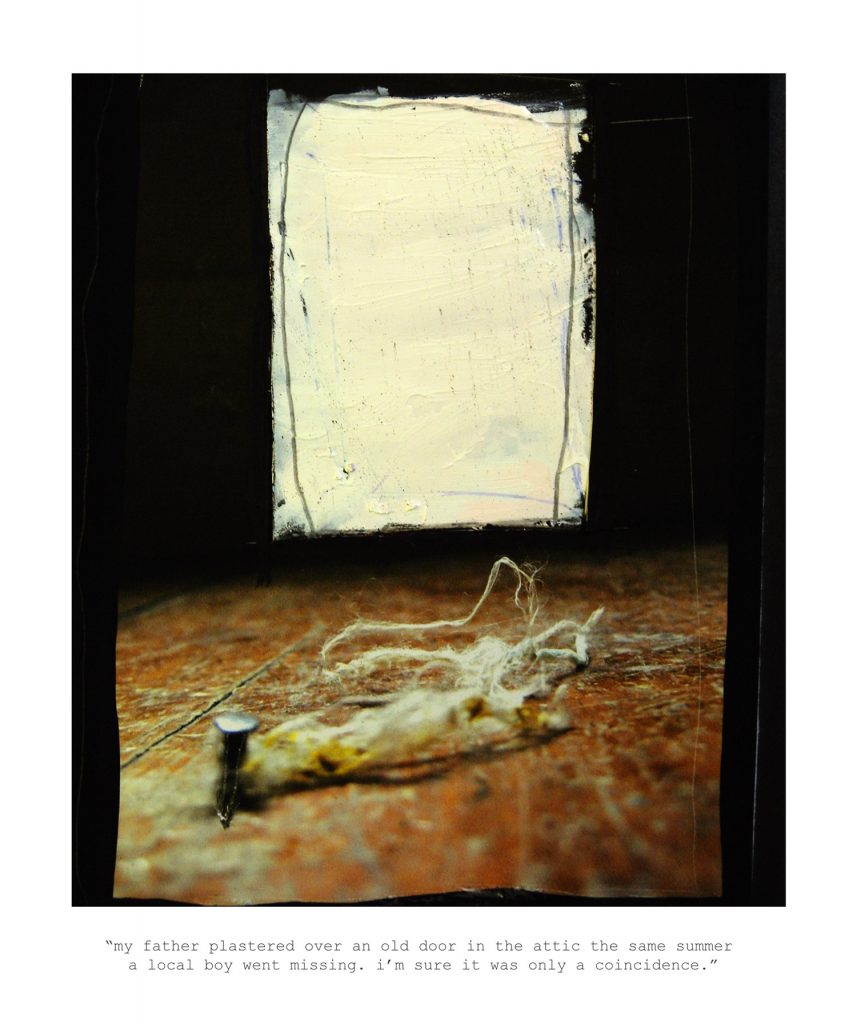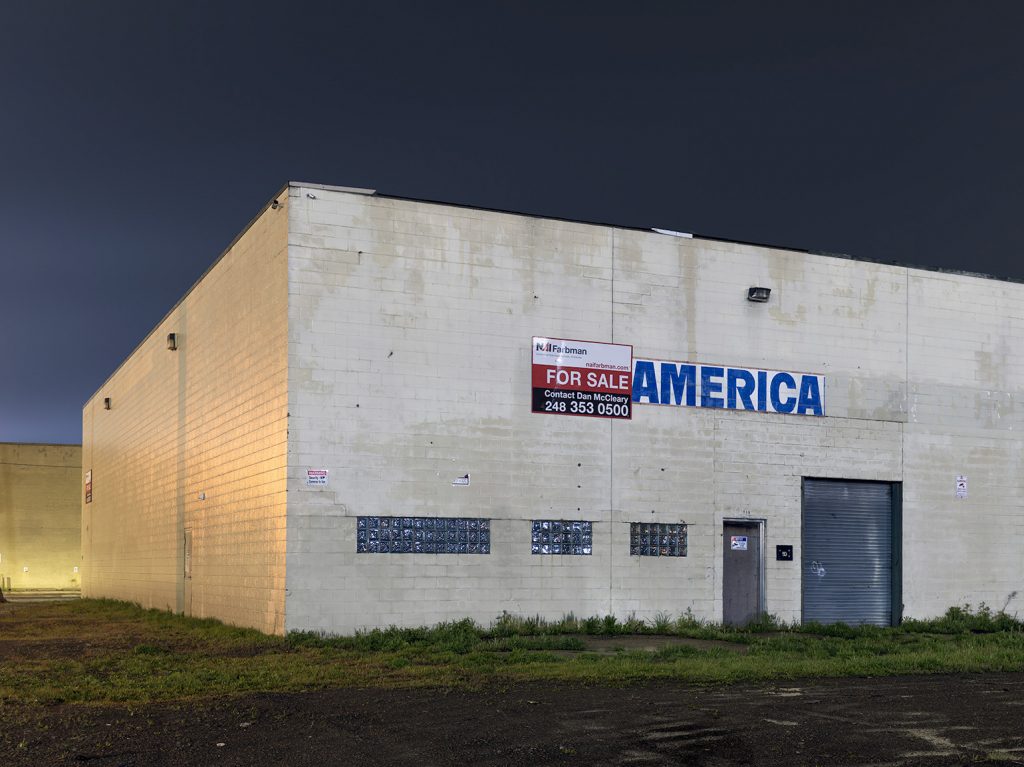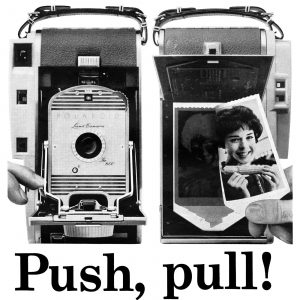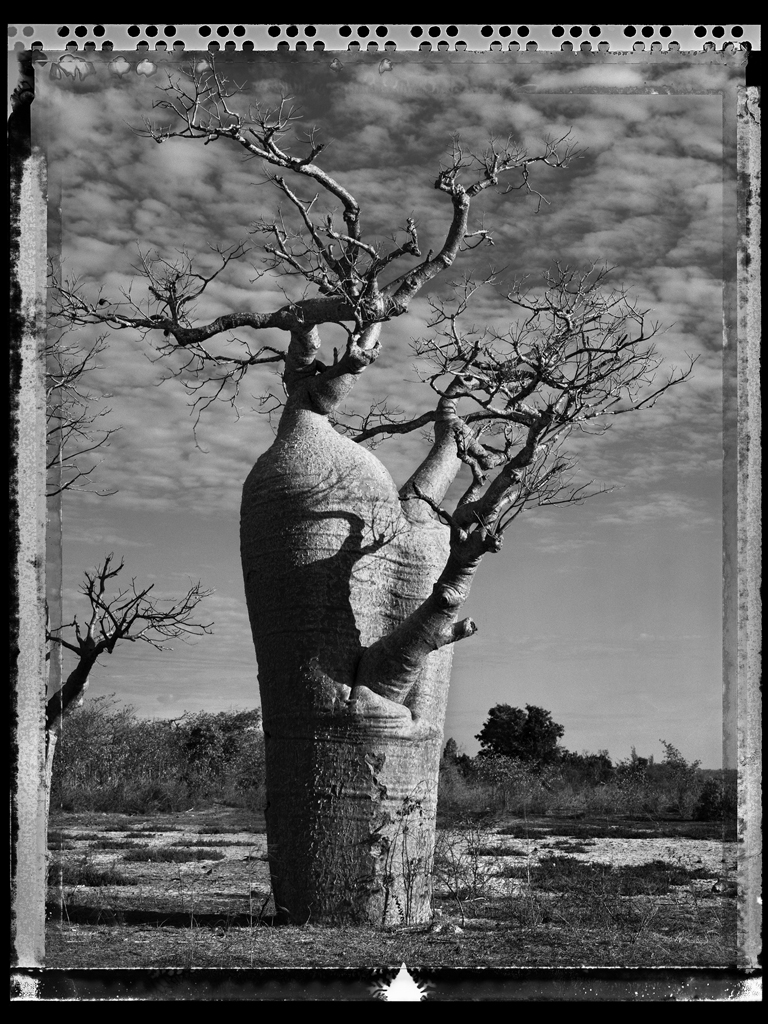In: analog photography

Gerald Slota | Home Sweet Home | 2010
October 30, 2023Gerald Slota | Home Sweet Home | 2010
(in collaboration with Neil LaBute)
Welcome to the midnight America, the one that exists parallel to the “real” world. It’s a dark country, one where men with hooks haunt Lover’s Lane and scarecrows walk on moonlit nights. It’s the place where people go when they slip into the cracks between light and darkness, a world of routewitches and oracles, demons and ambulomancers.
The rules are different here, and everyone’s playing for keeps. Be careful. Be cautious. And listen to the urban legends, because they may be the only things that can save you from the man who waits at the crossroads, hunting souls to keep himself alive.
Welcome to the ghostside.
Home Sweet Home is a collaboration between Gerald Slota and playwright Neil Labute. Introduced to each other in 2008, they began corresponding and working together (via email, for the most part, as they did not actually meet in person until – fittingly – an exhibition of this work in New York City in October 2010.) From the statement about Home Sweet Home : “For the first time Slota’s visual narratives are aligned alongside written narratives. The series title serves as an ironic reference to much of the early material’s dark focus on themes of home and family.”
The world that Slota and LaBute present us with is the descendant – a successor, in some ways – of the sites and landmarks from Michael Lesy’ The Wisconsin Death Trip. Denizens of a desperate world, sometimes leading lives of ‘quiet desperation’ (but not always, as secrets fester and explode, unable to be contained forever, just as some of the ‘narrators’ of these images must share what they have held inside….)
I also interpret these as postcards from the characters in Harmony Korine’s infamous film Gummo (1997) : a ‘loose narrative follows several main characters who find odd and destructive ways to pass time, interrupted by vignettes depicting other inhabitants of the town.’ That descriptor could apply to Home Sweet Home as well as Korine’s experimental film….
LaBute – whose words offer an unsettling nuance and depth to Slota’s images here – has also observed that “we humans are a fairly barbarous bunch”…..
This isn’t a new concept—the idea that stories change things, rewrite the past and rewrite reality at the same time…
The true secret of the palimpsest skin of America is that every place is different, and every place is the same. That’s the true secret of the entire world, I’d guess, but I don’t have access to the world. All I have is North America, where the coyotes sing the moon down every night, and the rattlesnakes whisper warnings through the canyons.
The true secret of the skin of America is that it’s barely covered by the legends and lies that it clothes itself in, sitting otherwise naked and exposed.
More of Gerald Slota’s work can be enjoyed here. Slota was also a recently featured Artist You Need To Know from AIH Studios’ continuing series : that can be enjoyed here.
All italicized quotes are from Seanan McGuire‘s books Sparrow Hill Road (2014) and Girl in the Green Silk Gown (2018) from her Ghost Road series. In these stories the urban legend of ‘Resurrection Mary‘ is told from the point of view of the dead girl Rose Marshall who’s been wandering the highways and back roads of a ‘secret’ United States of America since her death in 1952….
~ Bart Gazzola
Read More
Dimitri Tsykalov | MEAT | 2007 – 2008
July 28, 2023Dimitri Tsykalov | MEAT | 2007 – 2008
It’s not a new idea that firearms make acts of violence ‘too easy’, almost ‘antiseptic’, as they minimize the necessary physical contact intrinsic to other acts of brutality. This is an idea that’s been raised about technology since we began using it to kill each other.
(At the risk of seeming flippant, I must also inject a quote that came to mind when I first encountered images of Tsykalov’s MEAT : Invariably, the first question asked about a new technology is, “Can this make killing less of a hassle?” The second being, “Can I have sex with it?”…)
The implicit ‘removal’ or ‘remoteness’ (I’m reminded of the ski pole scene from Timothy Findley’s The Wars, for example, where the firearm and act of murder almost seem separate from the character himself) makes it almost a ‘trivial’ or ‘throwaway’ action to fire a gun.
Dimitri Tsykalov’s MEAT works offer a counter to that, in a grotesque manner that is excessive : I’ve debated writing about Tsykalov’s ‘armaments’ for a while, unsure if they’re too flippant, or too horrifying, or a combination of both that is as unpalatable as gripping cold flesh while your hands are stained and overrun with effluvia…
These works don’t pretend to an aesthetic distance (like in Serrano’s work, or some other artists I’ve talked about here who – like myself, when I worked with fat, bone and meat for over two decades – are interested in creating inappropriately beautiful artwork) : I feel that Tsykalov takes pleasure in our revulsion and wants to evoke it from us, and considering what he’s ‘butchering’ the meat, flesh and bone into, this is not inappropriate. There’s a swagger here, a bravado that intends to make us ill. Meat and guns are, after all, metaphors for penises or toxic masculinity, and Tsykalov alludes to that (even with the titles that reference specific guns).
Tsykalov, in creating work that intersects with brutality and our capacity for it, as a species, has taken an opposing artistic path to someone like Ralph Ziman with The Ghosts Project (a past Curator’s Pick you can see here).
Tsykalov’s own words : “In these pictures I recognize the murderers within me, I recognize love and death within me; in these pictures I recognize my flesh as the cannon fodder it is and will be for the rest of my life. In contrast the secondary meat in these shots – the one that rots and that kills, the animal meat that is used to create the fleshy weapons – seems unscathed, sanguine and elegiac. It is incredibly alive, it is cannon flesh and we are already mortal.”
Dimitri Tsykalov was born in Moscow (1963) where he attended Polygraphic Institute of Moscow (1982-1988). He currently lives and works in Paris.
More of his work can be seen here.
~ Bart Gazzola
Read More
Dave Jordano | For Sale – America, Westside, Detroit, 2020, from his A Detroit Nocturne Series
March 2, 2023Dave Jordano | For Sale – America, Westside, Detroit, 2020, from his A Detroit Nocturne Series
In the West, the past is very close. In many places, it still believes it’s the present. (John Masters)
Speramus meliora; resurget cineribus | We hope for better things; it will arise from the ashes. (City of Detroit’s motto)
The city makes you; in a million little ways it makes you, and you can’t unmake yourself from it. (Craig Davidson, Cataract City)
Detroit is nothing if not a physical site of contested narratives: having lived in Windsor – Detroit for a half dozen years, the mythology and the reality of that city was something I was exposed to as I was just beginning to mature as an artist and writer, and that city (whether through the Detroit Institute of Arts or the stereotypes of the rust belt wonderlands, the legacy of the riots and so much malfeasance on the part of supposed stakeholders that layer ruin upon ruin) played a large part in my development. Eight Mile Road is not just a song by Eminem, but a real place, with real people, to me.
It’s unsurprising to find out that Jordano is from Detroit: his portraits of the city suggest an affection and an affinity that is more personal, and that he connects with his subjects – whether people or places – in a manner that is more gentle, despite the harshness of the locus he captures, often being abandoned, or the stark industrial lights that help define his scenes. Or perhaps it’s more like one of my favourite books about place and memory, where Craig Davidson talks about how “the most awful thing about living as an adult on the same streets where you grew up? It’s so easy to remember how perfect it was supposed to be. Reminders were always smacking you in the face. Good things happened—sure, I knew that. They just happened in other places.”
Jordano’s own words about this series are as follows: “I chose to make these images at night not only to put more emphasis on their surroundings, but also because I wanted to introduce a moment of quiet and calm reflection. These nighttime landscapes seem unfamiliar and therefore provoke contemplation. Pieces of the past, present, and future are rendered here to be carefully considered. They are, after all, the physical evidence of the city where we once carved our collective ambitions and lived out our dreams.”
I must inject more words – to augment or challenge Jordano’s own – from Craig Davidson’s Cataract City here: “Most of us in Cataract City were hard because the place built you that way. It asked you to follow a particular line and if you didn’t, well, you went and lived someplace else. But if you stayed, you lived hard, and when you died you went into the ground that way: hard.”
Much more of Jordano’s work can be enjoyed at his site as well as on Instagram.
His extensive body of work – under the title of A Detroit Nocturne – can be viewed here.
~ Bart Gazzola
Read More
The Great Texas Road Story | Stephen Hood
February 25, 2023The Great Texas Road Story | Stephen Hood
IG: @thegreattexasroadstory
https://www.thegreattexasroadstory.com/
I refuse to remember the dead.
And the dead are bored with the whole thing.
But you — you go ahead,
go on, go on back down
into the graveyard,
lie down where you think their faces are;
talk back to your old bad dreams.
(Anne Sexton, A Curse Against Elegies)
Well, I see your light’s still on, so I guess you must be out there. It’s okay if you don’t want to talk, you know. I don’t want to talk either, sometimes. I just like to stay silent. (Nastassja Kinski | Jane Henderson, from the film Paris, Texas)
The scenes that make up The Great Texas Road Story are cinematic. This is not just the nature of the vignettes captured, but that encountering this work on IG, it is like a continuing tale, with missives ‘sent’ to us, like an ongoing conversation or ‘postcards’ in a continuing narrative….
They have a quality of scouting locations for a film, but I will admit that I’m bringing in my subjective response, again.
Looking at some of these, I’m – obviously, due to the title of the endeavour – reminded of the fine cinematography of the film Paris, Texas, by Robby Müller. But I’m also reminded of the television series Carnivàle, where a travelling carnival trudges across the United States amidst the arid dustiness and despair of the Dust Bowl Depression. Like the moments photographer Stephen Hood presents in The Great Texas Road Story, the episodes in that series are named after the small towns they traverse – and it all starts in Marfa, Texas, in an odd synchronicity to Hood’s travels around Texas for this project. Looking at the site for The Great Texas Road Story, empty places like Spur and Snyder might be Marfa – or vice versa.
And in the end, these places – despite their evocative physical presence captured by Hood – are also characters in a story, repositories for memories and ideas both personal and more public.
“The Great Texas Road Story is an ongoing photography project devoted to the authentic small Texas town. I aim to continue to artistically capture the places in Texas I find compelling and to share that work here.
This photography project began organically in June 2020, when suddenly, I had to get out of town with my girlfriend, as we hadn’t left our tiny Austin apartment in months, and we needed to do something. Had to go. So we booked a campsite at the state park and headed out west to camp in the Davis Mountains near Marfa. A good ole Texas road trip (soothes the soul) was soon underway.
Our first stop was San Angelo, where we saw a porcupine. I brought an old camera and started photographing the landscape of Texas. I hadn’t picked up a camera in months, but from then on, we were on the road every other weekend documenting all of the small towns along the way.
I only moonlight as a Texas documentarian…It is in my spare time that I lovingly chronicle a disappearing Texas.” (Stephen Hood)
That’s an excerpt of Hood’s description of this work, and more of his images can be seen here: but you’ll be able to enjoy more of these moments if you give The Great Texas Road Story a follow on Instagram here.
~ Bart Gazzola
Read More
Krydor, SK | Danny Singer, 2014
February 17, 2023Krydor, SK | Danny Singer, 2014
I would walk to the end of the street and over the prairie with the clickety grasshoppers bunging in arcs ahead of me, and I could hear the hum and twang of wind in the great prairie harp of telephone wires. Standing there with the total thrust of prairie sun on my vulnerable head, I guess I learned — at a very young age — that I was mortal.
W. O. Mitchell, Who Has Seen The Wind
I first encountered Danny Singer’s work in an exhibition in Saskatoon curated to mark the centennial of the province at the Mendel Art Gallery. Most of the artists included had celebratory discourses at play about the place in their work, but there were a few more factual as regards the history – and present – of that province. The Mendel Art Gallery (now the Remai Modern), under the curatorial eye of Dan Ring at that time, often eschewed banal propaganda for more real dialogue, as with the 2002 exhibition Edward Poitras: Qu’Appelle: Tales of Two Valleys. That exhibition’s title “refers to two valleys: a metaphor for the way First Nations and colonists, both past and present, constructed and experienced nature, spirituality, and culture through the physical reality of the Qu’Appelle.” (from the curatorial statement for the exhibition by Dan Ring).
This also acts as another ‘place’ to stand and consider Singer’s ‘sites’, too.
Singer’s works have an element of the performative: if you’ve ever been to the small towns – or similar ones – he’s documented in Saskatchewan and Alberta, you know that they are sparse, spaced and dying, if not already dusty corpses featured in a form of photographic nostalgia that has an element of necrophilia.
Other works in this series shift the camera so that the sky dominates the majority of the composition, so solid and blue it looks hammered into place, with clouds moving like the ocean, and the towns almost miniscule below all of this. Mitchell’s sentiment about the transience of humanity in the face of the eternity of nature is at play in those works, too.
“In Singer’s large-scale composite photographs, there is a real tension between the assumptions of photography as a medium – the fixed point of the camera, capturing a single moment in time – and the reality of the artist’s process, which takes hours and involves hundreds of vantage points. To the viewer, the photographs have a collapsing effect: the passage of time witnessed in a single glance.
The Vancouver-based artist has spent fifteen years photographing the main streets of small towns and hamlets across the prairies and plains of North America, drawing attention to the rural, agricultural communities on which Canada’s economy was built. In these large-scale works, strings of vernacular buildings are dwarfed by a dynamic sky, which fills the visual field. Out of the frame, one can imagine the horizontal repetition of this diminishing effect—farmland stretching hundreds of miles in either direction.” (from Galleries West)
More of Singer’s work can be seen here.
~ Bart Gazzola
Read More
The Polaroid Book : Selections from the Polaroid Collections of Photography
January 5, 2023The Polaroid Book : Selections from the Polaroid Collections of Photography
Edited by Steve Crist, Essay by Barbara Hitchcock
Taschen 2005

As a photographer, and especially as one who has shot a lot of instant film, I could wax poetic about the wonders of the Polaroid film process; that it was invented in 1947 by Edwin Land and his Polaroid Corporation; that he formed a partnership with Ansel Adams to explore the artistic capabilities of the medium in 1948; that Land and the Corporation made hundreds of cameras and film available to artists around the world on the condition that they gave some of their images to Polaroid’s collection of photos. I could tell you that it was THE photographic medium of the 50’s, 60’s, 70’s and 80’s and that creating a photo was indeed as easy as “Push, pull!”. However, there are so many writers and photographers out there who have extolled the virtues of the process over the last 75 years that I can’t possibly say anything new.
The Polaroid Book : Selections from the Polaroid Collections of Photography tells the story in 254 photographs by 203 artists. The photos include black and white documentary and landscape images taken with the cumbersome early models of the Polaroid line of cameras to incredibly immersive large format color images made by celebrated artists and fashion photographers. The creativity in these polaroids is boundless. From Adams to Warhol with a little Close and Hockney in between, Polaroids were a tool used by well (and lesser) known artists to create stunning pieces of work. Chuck Close’s Self-portrait (seen below) stands out; a mosaic made up of 9 separate images to create a large, somewhat disjointed selfie in Close’s trademark (and usually painted) style.
Perusing this book will lead you to want to try capturing this photo-magic yourself, which you can do by using Fujifilm’s Instax line of film and cameras. Anecdotal evidence points to these colourful, well designed cameras acting as lures to teens everywhere to further explore the possibility available to them in analog photography as a creative outlet. It is one of the reasons that film sales are quickly growing again after years of domination of the market by digital photography.
The Polaroid Book is available from numerous online and bricks-and-mortar retailers.
~ Mark Walton
Read More
Jane Evelyn Atwood | TOO MUCH TIME: WOMEN IN PRISON, 2000
November 25, 2022Jane Evelyn Atwood, TROP DE PEINES: FEMMES EN PRISON, 2000, Éditions Albin Michel, Paris, France. (OUT OF PRINT)
Jane Evelyn Atwood, TOO MUCH TIME: WOMEN IN PRISON, 2000, Phaidon Press Ltd., London, England. (OUT OF PRINT)
“Curiosity was the initial spur. Surprise, shock and bewilderment soon took over. Rage propelled me along to the end.”
Too many times – and I’m sure I’m not alone in this – I have heard some well meaning dilettante assert that ‘art should be about beauty’ or ‘should only uplift us.’ In terms of that space where photography intersects with ideas of art and documentary – and not to mention history – something that comforts you is most likely wrong, if not simply pablum. When I’m sharing images on social media, there are some photographers I hesitate to post works from (as photography still carries the weight of being more ‘real’, thus can ‘offend’ as well as see yourself banned from those platforms): Gilles Peress is one of those, for his unflinching lens in places from Rwanda to the former Yugoslavia (“I don’t trust words. I trust pictures”), Gordon W. Gahan (specifically his images of the Vietnam War), Donna Ferrato (I was lucky enough to experience her groundbreaking series Living with the Enemy decades ago, in Windsor) or Martha Rosler (her House Beautiful: Bringing the War Home works that had their genesis in response to the Vietnam War (c.1967–72) but that she ‘revisited’ in 2004 and 2008, ‘updating’ them to Iraq and Afghanistan).
But the text I’ve selected for a Library Pick is something that is not ‘there’ but ‘here’, and in that respect is often – easily, repeatedly – ignored.
Jane Evelyn Atwood’s “monumental work on female incarceration, published in both French and English, took Atwood to forty prisons in nine different countries in Europe, Eastern Europe, and the United States. The access she managed to obtain inside some of the world’s worst penitentiaries and jails, including death row, make this ten-year undertaking the definitive photographic work on women in prison to date. Extensive texts include interviews with inmates and prison staff as well as Atwood’s own reminiscences and observations. The prize-winning photos in this book, including the story of an incarcerated woman giving birth while handcuffed, established Jane Evelyn Atwood as one of today’s leading documentary photographers.” (from her site)
Atwood has always used her camera as a means to tell stories too often not even dismissed but denied, and she has granted a level of dignity and consideration to those whom are too often not considered human but detritus.
A good friend is a theologian, but of the liberation theology vein: I enjoy talking with them, as their righteous anger is only matched by their ability to quote that repeatedly translated and edited text with a sense of the public good. I mention them as they once pointed out that in the New Testament, only one person was promised a place in the ‘kingdom of heaven’, and that was one of the criminals being crucified at the same time as Jesus.
In a more modern sense, I might cite Lutheran Minister (and ‘public theologian’) Nadia Bolz-Weber‘s contemporary addendum to the beatitudes, which include ‘Blessed are those who have nothing to offer. Blessed are they for whom nothing seems to be working.’
Atwood published ten books of her work and been awarded the W. Eugene Smith Grant in Humanistic Photography, the Grand Prix Paris Match for Photojournalism, the Oskar Barnack Award, the Alfred Eisenstadt Award and the Hasselblad Foundation Grant twice.
More of Atwood’s work can be seen here.
Like several of the books I’ve recommended, this is one I came across in my local library.
~ Bart Gazzola
Read More
Elaine Ling | Baobab #31 – 2010, Madagascar
November 19, 2022Elaine Ling | Baobab #31 – 2010, Madagascar
Ce qui embellit le désert, dit le petit prince, c’est qu’il cache un puits quelque part…[What makes the desert beautiful, said the little prince, is that somewhere it hides a well…]
It is an odd feeling to encounter the work of an artist, seeing how prolific they are and be enamoured of their practice, then discover that they passed a few years ago. I’ve often had the same experience with authors (I have a habit of finding the work of a writer that is new to me, and consuming all the books, and it’s an empty sadness when you realize they won’t be creating any more).
This image is one from a series titled Baobob, by the late Elaine Ling (1946-2016). At her site it is the final series presented, from an extensive and enthralling body of work.
It can be read as having the quality of an epitaph: these massive, seemingly eternal natural ‘monuments’ that have survived her, and will likely survive all of us.
In that manner I have of being ‘too subjective’, Baobob trees remind me of Antoine de Saint Exupéry’s novel Le Petit Prince (1943): to me, it’s a melancholy story, about loss and death, with touching moments of truth that have contributed to how it – despite often being considered a story for children – speaks to many adults, like myself.
“Seeking the solitude of deserts and abandoned architectures of ancient cultures, Elaine Ling…explored the shifting equilibrium between nature and the man-made across four continents. Photographing in the deserts of Mongolia, Ethiopia, Madagascar, Timbuktu, Namibia, North Africa, India, South America, Australia, American Southwest; the citadels of Ethiopia, San Agustin, Persepolis, Petra, Cappadocia, Machu Picchu, Angkor Wat, Great Zimbabwe, Abu Simbel; and the Buddhist centres of Myanmar, Laos, Vietnam, Tibet, and Bhutan; she has captured that dialogue.” (from her site)
Voici mon secret. Il est très simple: on ne voit bien qu’avec le cœur. L’essentiel est invisible pour les yeux [Here is my secret. It is very simple: It is only with the heart that one can see rightly; what is essential is invisible to the eye].
On the first of August, 2016, Elain Ling lost her battle with lung cancer: her brother – Edward Pong – has indicated that he intends to continue to foster her legacy, through the maintenance of Ling’s site.
It is an impressive space with much more about Ling’s life and work – and many more of her moments from her life and around the world – that can be enjoyed here. C’est véritablement utile puisque c’est joli [It is truly useful since it is beautiful].
All quotes in italics are from Saint Exupéry’s The Little Prince .
Elaine Ling was also a recently featured Artist You Need To Know, in AIH Studios’ continuing series. You can enjoy that here.
~ Bart Gazzola
Read More
Walker Evans – James R. Mellow
May 19, 2022Walker Evans
James R. Mellow
Basic Books; Revised ed. edition (Oct. 11 2001)
Walker Evans is one of the most famous American documentary photographers of the past 100 years and his images will stand for another hundred at least. While every serious photographer is familiar with his work (the best known of which was shot during the 1930’s for the U.S. Farm Security Administration as per the examples below), there have been relatively few books that discuss Evans as a man. James R. Mellow captures his complexities in this eminently readable biography, published in 2001.
What makes particularly interesting reading is Evan’s evolution as an artist, from failed student in the Mid-West US, to failed writer in Paris, to acclaimed photographer on his return to New York in the late 20’s and early 30’s. The book quotes extensively from his letters and other writings. One can almost hear him speaking… I imagine his voice to be a low pitched, slow drawl; a mix of Henry Fonda, Peter Coyote and Alan Rickman (minus the accent).
Evans comes across as dour and fatalistic, yet strangely still likeable. Much of his writing describes his unhappiness with things as they are, whether it be his annoyance with his mother, his dissatisfaction with the quality of the prints made from his negatives or his despondence about his romantic relationships. Many of his friendships with other famous artists are discussed, including Ben Shahn, Steven Crane and Hanns Skolle.
The book offers details about the trips Evans made to do his photography and specifically the trips he made with author James Agee as they worked on the seminal Let Us Now Praise Famous Men. Evans plays the role of aesthete opposite Agee’s sensualist, the collision of which resulted in a book acclaimed for its intimacy and realism… a strong documentary account of the lives of sharecroppers and their families in the American South during the Great Depression.
It is sad but somehow inevitable that Evans ends his days as somewhat of an alcoholic / academic recluse. Mellow’s reliance on Evans’ own words leave you feeling as if you really knew him, that you cared about him, but weren’t overly close to the actual man behind the photographs, because of his determination to keep people at bay.
Walker Evans by James R. Mellow is available from numerous online retailers.
~ Mark Walton
Read More
Kary Janousek – Connecting to History
March 11, 2022Kary Janousek Connecting to History Wind - Kary Janousek Kary Janousek is a prairie transplant. She found herself living in Fargo,... Read More
Recent Comments